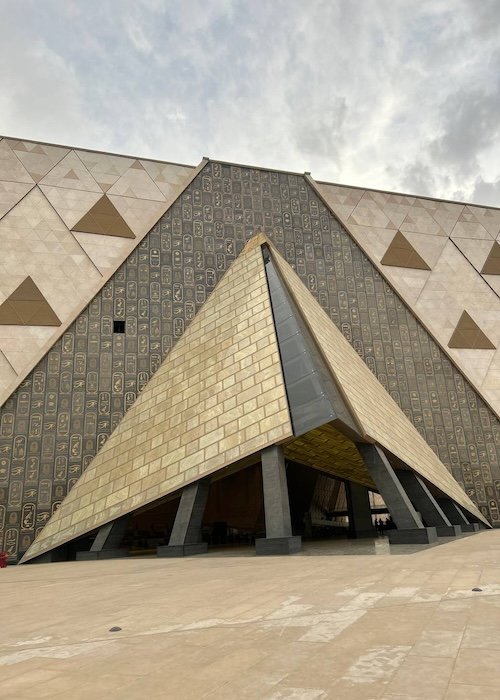The Grand Egyptian Museum stands as a monumental testament to Egypt’s commitment to preserving its ancient heritage while ushering it into the modern era. Nestled near the Pyramids of Giza, this museum, officially known as the Grand Egyptian Museum (GEM), is one of the most ambitious cultural projects of the 21st century. It not only houses an extensive collection of artifacts but also provides an immersive, modern space that connects visitors with thousands of years of history, from the predynastic period to the Greco-Roman era.
The Long Road to the Grand Egyptian Museum
The vision for a new home for Egypt’s priceless relics began in 1992, when then-President Hosni Mubarak called for a new museum to consolidate and display the country’s wealth of antiquities. The Egyptian Museum in downtown Cairo, dating back to 1858, had become crowded, its displays lacking the space and technology to do justice to the significant artifacts they contained. A new museum would not only solve these issues but also provide a more sustainable location for the preservation of these treasures. The Grand Egyptian Museum was conceived to accommodate Egypt’s cultural patrimony on a grand scale, befitting the majesty of the ancient civilization.
A location was chosen just 1.2 miles (2 km) from the Pyramids of Giza, where the new museum could stand proudly among its ancient counterparts. This location also provides visitors with a pyramids and museum experience, seamlessly integrating a visit to the iconic Giza plateau with an exploration of Egypt’s storied past through a modern lens. In 2002, the Egyptian Ministry of Culture launched an international architectural competition to design the museum. From over 1,500 submissions, the design by Heneghan Peng Architects, based in Dublin, was chosen, capturing the essence of modernity while honoring Egypt’s ancient architectural forms.
Construction and Challenges
Construction of the grand Egyptian museum began in 2005, with its colossal scale promising to be the largest archaeological museum in the world, occupying over 120 acres (50 hectares) of land. However, the road to completion was fraught with challenges. The project faced several delays, first due to the political upheaval of the Arab Spring in 2011, which saw President Mubarak resign and many national projects halt. After a hiatus of three years, work resumed in 2014, funded through international donations and Egyptian government resources. Yet, the COVID-19 pandemic again interrupted progress, pushing back the much-anticipated opening.
Despite these obstacles, the museum took shape, and in October 2024, parts of the egyptian grand museum opened to the public. The full opening remains on the horizon, with a complete unveiling yet to be scheduled. However, the glimpse provided to visitors and the grandeur of the structure have already garnered widespread acclaim.
A Museum Fit for a Pharaoh
The grand Egyptian museum is designed to echo the architectural majesty of Egypt’s most famous monuments. Its facade is covered in a striking pattern of triangles, reminiscent of the geometric precision of the Pyramids of Giza, which loom just beyond the horizon. Upon approaching the entrance, guests pass through an alabaster-clad doorway, adorned with hieroglyphic inscriptions, symbolizing the gateway to ancient mysteries. Beyond this threshold lies a shaded atrium dominated by the imposing, 3,200-year-old statue of Ramses II, one of the museum’s centerpieces.
From there, visitors ascend a grand staircase, lined with statues of ancient Egyptian royalty and deities, leading them into the heart of the museum. The interior design is sleek and spacious, with sloping ceilings and expansive exhibition halls that make use of both natural and artificial light to create a dynamic, ever-changing environment. Tall windows offer unobstructed views of the nearby pyramids, blending the ancient and the modern in a single vista that underscores the museum’s thematic continuity.
Artifacts on Display: Highlights of Egypt’s History
One of the Grand Egyptian Museum’s biggest draws is its unparalleled collection of artifacts. The museum has gathered tens of thousands of items from across Egypt, many of which have never before been displayed to the public. The crown jewel of the collection, however, is undoubtedly the cache of treasures from the tomb of King Tutankhamun. Tutankhamun, often referred to as the “Boy King,” was thrust into the global spotlight upon the discovery of his nearly intact tomb in 1922. In GEM, for the first time, visitors will be able to view almost all of the more than 5,000 items recovered from his burial site.
The exhibition includes his gold funerary mask, inner sarcophagus, jewels, and throne, each displayed in conditions carefully designed to mimic those of the original tomb. Additionally, the museum houses other invaluable pieces, such as the black granite statue of Queen Nefertiti, a four-ton pink granite sculpture of Amenhotep III seated beside the sun god Ra, and the solar boat of King Khufu, previously exhibited near the Great Pyramid. This unprecedented collection offers an expansive view of Egypt’s rich cultural and artistic legacy.
Mummies and Mysteries
Although much of the attention has been focused on Tutankhamun, the grand Egyptian museum also includes a carefully curated collection of royal mummies. In April 2021, 22 royal mummies were transferred from the Egyptian Museum in Cairo to their new home during the Pharaohs’ Golden Parade, a grand, state-sponsored event that captured the world’s imagination. Among the mummies on display are those of some of Egypt’s most iconic rulers, including Ramses II and Hatshepsut. These mummies are presented alongside information about their lives, reigns, and the preservation techniques that have kept them remarkably intact for thousands of years.
The royal mummies will not be part of the same exhibit as Tutankhamun, but rather housed in dedicated galleries where state-of-the-art conservation techniques ensure their continued preservation. The atmosphere in these rooms is controlled to maintain the delicate balance necessary for the mummies’ protection, emphasizing the museum’s dual role as both an exhibition space and a center for conservation.
Modern Amenities and Expanding Horizons
The egyptian grand museum is not just about artifacts. It is an expansive cultural complex that aims to provide a complete visitor experience. The site includes eight restaurants, a food court, gardens, a 3D cinema, and commercial spaces, ensuring that a visit is not just educational but also comfortably accommodating for families and tourists. The 484,000 square feet of floor space also includes specialized conservation laboratories, which are among the largest in the world, where thousands of artifacts have already been meticulously restored.
Leading the museum is Major General Atef Moftah, an unconventional museum director whose background as an engineer and military man is evident in the precision and ambition of the project. General Moftah has overseen the transformation of what was once a barren desert plot into a sprawling cultural landmark. Under his guidance, the museum is expected to attract between five to seven million visitors annually, cementing its status as one of the foremost cultural institutions in the world.
A Glimpse into the Future
While the grand Egyptian museum is not yet fully open, the sections that have been unveiled offer an enticing preview of what is to come. Visitors who have had early access to the museum describe it as a transformative space, where the ancient and the contemporary converge to tell Egypt’s story in new, powerful ways. Its location, near the towering Pyramids of Giza, creates a natural link between two of Egypt’s most significant symbols—its ancient heritage and its commitment to preservation for future generations.
The museum also aims to play a key role in Egypt’s broader cultural ambitions. It seeks to encourage the return of looted artifacts currently held in international institutions, such as the Rosetta Stone in the British Museum and the bust of Nefertiti in Berlin. By providing a world-class home for these artifacts, Egypt hopes to strengthen its case for their repatriation. The grand Egyptian museum symbolizes not only the preservation of the past but also the aspiration of a nation that seeks to reclaim and celebrate its cultural heritage.
Conclusion: A New Era of Egyptology
The grand Egyptian museum is far more than just a museum—it is a tribute to an ancient civilization that continues to captivate the world. Through its thoughtful design, inspired by the pyramids and reflective of modern sensibilities, the museum provides an unparalleled platform for experiencing Egypt’s past. Though the official full opening has yet to be confirmed, the glimpses offered so far make it clear that this is a project of unprecedented scope and ambition.
Standing near the Pyramids of Giza, the Grand Egyptian Museum bridges millennia of history, connecting the ancient wonders of the past with the cutting-edge technologies of today. It promises not only to be the biggest museum in the world dedicated to a single civilization but also a hub of education, culture, and tourism, drawing millions from around the globe to experience Egypt in a truly modern setting. Whether you are captivated by the treasures of Tutankhamun, intrigued by the mysteries of ancient mummies, or simply drawn by the sheer grandeur of the structure, the grand Egyptian museum offers a once-in-a-lifetime opportunity to connect with the enduring legacy of one of humanity’s most remarkable cultures.











